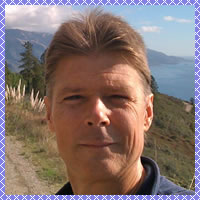William Garner Sutherland, D.O. invented Cranial Osteopathy in 1939. W.G. Sutherland, D.O. (1873-1954) was an early student of Dr. A.T. Still, who was the founder of Osteopathy. While a student at the American School of Osteopathy in the late 1890s he observed a skull, which had been mounted with each bone slightly separated from its articulation. He had the thought that the flat part of the temporal bone (which relates to the ear) was designed for motion, “like the gills of fish”. This was an inspirational moment that lay the seed for expansion of Dr. Still’s concept of Osteopathic philosophy into the cranial field. At that time anatomical texts had very little to say regarding the cranial bones.
He thus began a decades long inquiry, studying the disarticulated bones and their articular (joint) surfaces, until he was convinced that they were designed for mobility. He then experimented on his own cranium, and over a period of time started applying these principles to his patients. He had remarkable results, relieving a variety of problems for which there were no other treatments.
After thirty years of developing his diagnostic and treatment approaches, he began sharing his concepts and techniques with other interested Osteopathic physicians. His teachings are still taught today to Osteopathic and Chiropractic Students. |
















